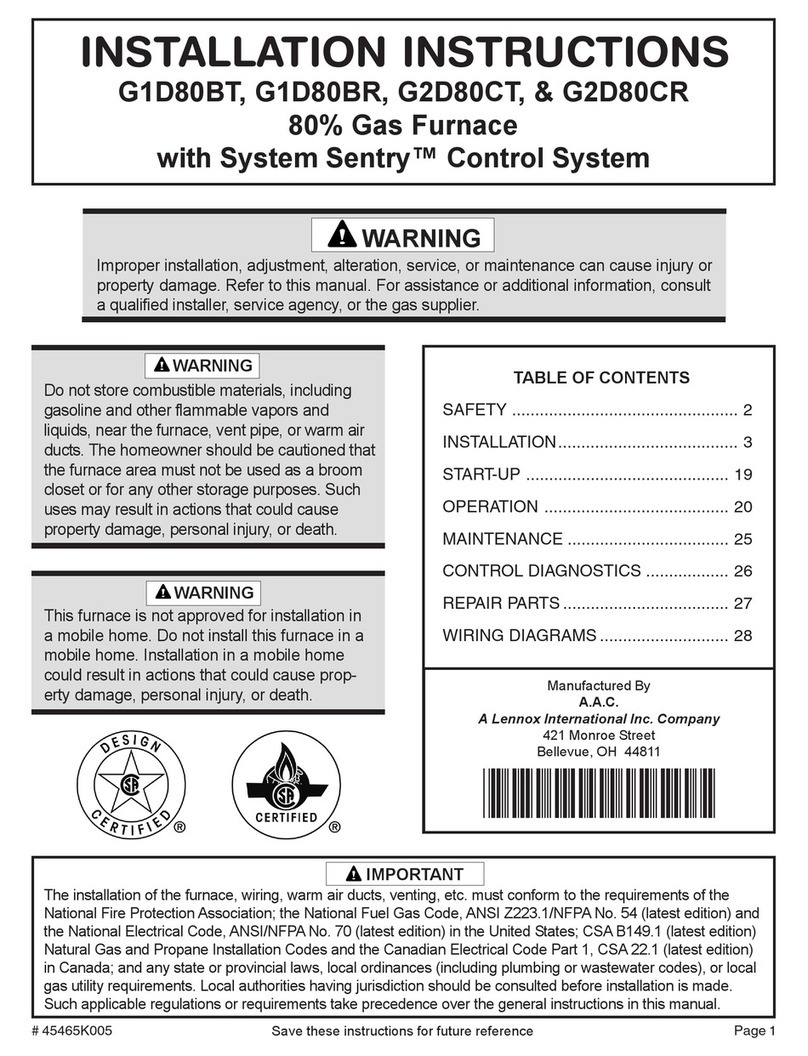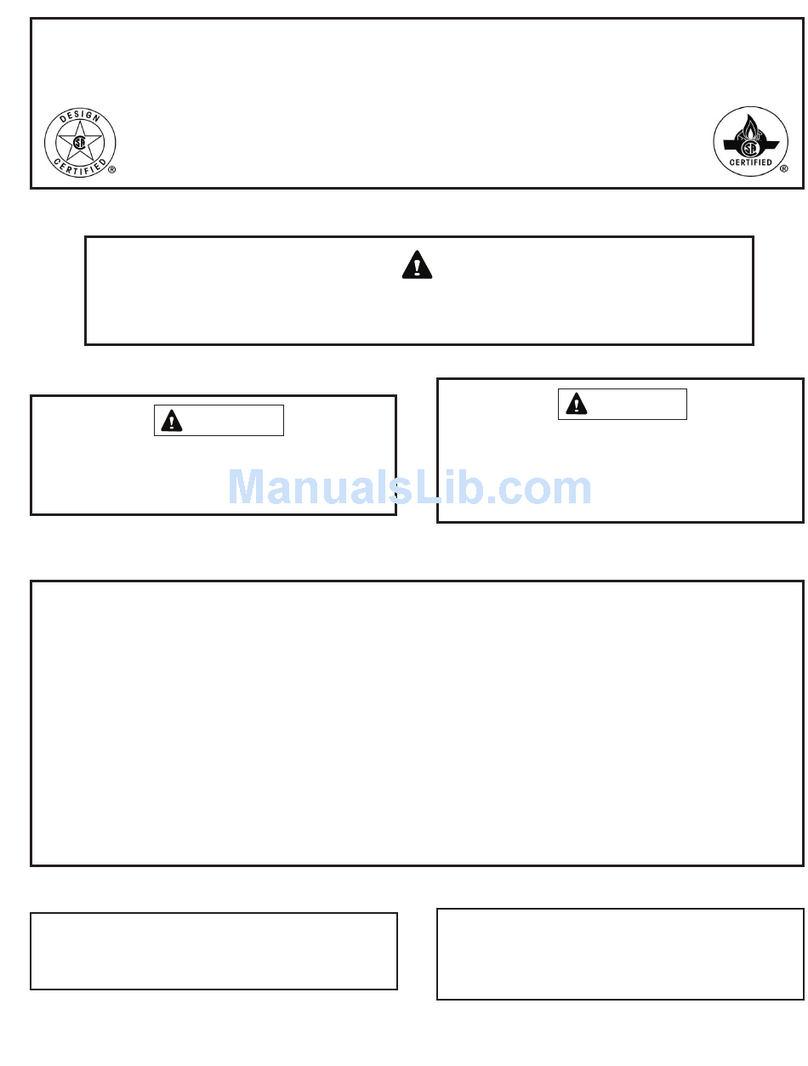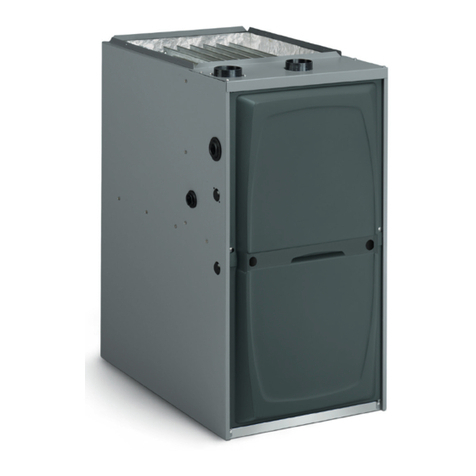
506303-01 Page 5 of 40Issue 0938
5. Exposure to the following substances in the combustion
air supply may also require outdoor air for combustion:
• Permanent wave solutions
• Chlorinated waxes and cleaners
• Chlorine-based swimming pool chemicals
• Water softening chemicals
• Deicing salts or chemicals
• Carbon tetrachloride
• Halogen-type refrigerants
• Cleaning solvents (such as perchloroethylene)
• Printing inks, paint removers, varnishes, etc.
• Cements and glues
• Antistatic fabric softeners for clothes dryers
• Masonry acid washing materials
• Chlorinated laundry products
• Hydrochloric acid
Venting
The high efficiency of this furnace is accomplished by the
removal of both sensible and latent heat from the flue gases.
The removal of latent heat results in the condensation of
moisture in the flue gases. This condensation occurs in the
secondaryheatexchangerandintheventsystem.Therefore,
this furnace requires special venting considerations and the
instructions must be followed to insure proper operation. All
venting must be in accordance with the codes having
jurisdiction in the area and these instructions.
G2D93CT, G2D93CU, G2D95CT, and G2D95CU models
canbeinstalledas either direct vent or non-direct vent units.
A direct vent (two pipe) installation requires that all the air
necessary for combustion be supplied from outside the
dwelling through an air intake pipe. A non-direct vent (one
pipe) installation uses air from inside the dwelling for
combustion.
The furnace is shipped with the air inlet pipe terminated to the
top panel for either inside or outside combustion air.An inlet air
restrictor plate (see Figure 2 on page 6) is supplied with this
furnace and can be found in the plastic bag containing these
InstallationInstructionsandtheUser’sInformationManual.This
inlet restrictor plate must be used in all installations using
inside air for combustion (non-direct vent).
The inlet restrictor plate must be installed in the air inlet in
one of three ways:
•Restrictor plate in inlet collar: Install the restrictor
plate in the inlet pipe collar in the top panel of the
furnace. Insert a 3" to 36" section of PVC pipe (field
supplied) into the collar. Use high temperature RTV
sealant to attach PVC pipe to collar. A 90° elbow (field
supplied) may be attached to the PVC pipe, but the
elbow is not required. Use high temperature RTV
sealant to attach elbow to PVC pipe (if applicable).
Confined Space
A confined space is defined as “a space whose volume is
lessthan50cubicfeetper1000BTUperhourofthecombined
input rating of all appliances installed in that space.”
Ifthefurnaceisinstalledinaconfinedspacewithinthebuilding
and combustion air is taken from a heated space, the
combustion air and ventilating air must enter and leave the
space through two permanent openings of equal area. One
openingshallbelocatedwithin12" ofthe ceilingandtheother
within 12" of the floor, each having a free area of
1 square inch per 1000 BTU/HR of total input rating of all
appliances within the space and not less than 100 square
inches each.
If the furnace is installed in a space within a building of tight
construction, makeup air must be supplied from outdoors. In
this case, one opening shall be within 12" of the ceiling and
one opening within 12" of the floor. If combustion ducts are
vertical, each opening shall have a free area of 1 square inch
per 4000 BTU/HR of the total input rating of all appliances
within the enclosure. If horizontal combustion ducts are run,
1 square inch per 2000 BTU/HR is required.
Contaminated Combustion Air
Excessiveexposuretocontaminatedcombustionairwillresult
in safety and performance related problems. The
recommended source of combustion air is outdoor air.
However, the use of indoor air in most applications is
acceptable if the following guidelines are followed:
1. If the furnace is installed in a confined space, it is
recommended that the necessary combustion air come
from the outdoors by way of an attic, crawl space, air
duct, or direct opening.
2. If indoor combustion air is used, there must be no
exposure to the substances listed in Item 5.
3. All provisions for indoor combustion air must meet the
requirementsforcombustionair indicatedinthe National
Fuel Gas Code,ANSI Z223.1/NFPA54 (latest edition),
and/oranyapplicable local codes. In Canada, seeCSA
B149.1, Natural Gas and Propane Installation Codes
(latest edition).
4. The following types of installation may require outdoor
air for combustion, due to chemical exposures:
• Commercial buildings
• Buildings with indoor pools
• Furnaces installed in laundry rooms
• Furnaces installed in hobby or craft rooms
• Furnaces installed near chemical storage areas

































